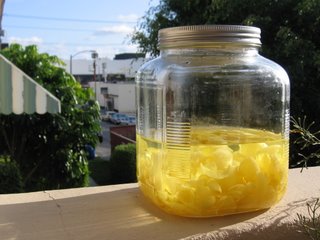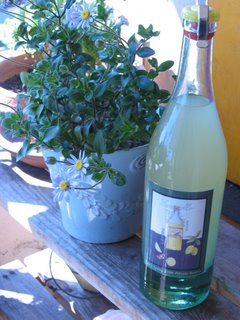I blame Vietnamese food for my latest obsession: limoncello. (Jamie Oliver and a pasta maker left behind by a former boyfriend were responsible for last year’s passion for homemade pasta.) It may sound like a leap, from bahn cuon to Italian liqueur, but because I’m writing a book about the former, I started reading Best Food Writing 2005, for inspiration and to check out what other foodie scribes are up to these days.
I opened the anthology at random, and the first essay I read was Bitter Alchemy, by Deirdre Heekin (originally published in Gastronomica). Heekin writes eloquently about her discovery of rosalio, in which you “gather roses in perfect bloom during the hottest hours of a June day when their perfume is at their headiest.” Making liqueur in such a way sounded like the most romantic pursuit in the world, but I was reading about it in December, not June.
As I began researching, in preparation for gathering my own roses come summer, I learned about other appealing sounding liqueurs, such as nocino (which requires green walnuts picked in June, as well) and limoncello. I’m ashamed to say that I’d never heard of limoncello, but my cousin Jeanne had, and assured me it was worth making. December in most places may not be prime harvest time, but in L.A., at least in the driveway behind my apartment, it is when my lemon tree starts bearing bear fruit.

The lemons on my tree are the most miraculous tasting fruit I’ve ever eaten. Their flavor is sharp, tart and pure. When they are in season, I squeeze them onto everything I make, from broiled salmon to artichoke pasta. I’m the only person in our apartment building who picks them (this still boggles my mind), and I can never use them all up. My discovery of limoncello seemed serendipitous, the perfect way to use every single lemon on the tree and to pass the time until I could tackle rosalio and nocino.
Nowadays, my first step when plotting a new concoction is to get online and check out every recipe available. I found six good limoncello recipes, all authoritative and all different. So I hopped onto eGullet and spent an entire afternoon reading the seven-page forum on limoncello, moderated—unofficially—by a lemon liqueur queen named Katie Loeb. The main argument in the forum was whether to use grain alcohol or vodka. Most voted for vodka, but a few purists were adamant—grain alcohol is what is used in Italy, and without it, you can’t make the real deal. I decided to try both.
My first batches were finally ready last week. The vodka batch is good, but the bottom line—in my opinion—is you can taste the vodka. It’s like some yummy lemondrop-type cocktail you might order in a fancy bar here in L.A. The grain alcohol version, on the other hand, is smooth and unique. The friends I’ve had the chance to test it on agree.
Following is how I stumbled my way through the process and came up with Batch #1 of the grain alcohol version. A few days ago, I started on Batch #2 with the last of the lemons from my tree. I plan to play with it a little, as I explain in the recipe below. Check back in three months for the result.

Limoncello, Phase One
- Choose 24 medium size lemons or 12 large lemons. When I say large, I mean huge. The ones from my tree are the size of grapefruit. Use organic lemons, since the alcohol is going to suck out every bit of oil (and pesticide, if it’s there) from the zest.
- Peel the zest from the lemons. Make sure not to get any pith, since it will make the liqueur bitter. I’ve heard that a microplane works well, but since I don’t have one, I used a serrated vegetable peeler.
- Put the skins in a jar and dump in two 750 ml bottles of 150 proof Everclear. Leave in the jar in a cool, dark place for approximately three weeks. You’re ready to move on when the zest has turned white and the alcohol is yellow.
Limoncello, Phase Two
- Strain the zest from the alcohol. Squeeze any oil, if possible, from the zest and add to the alcohol.
- Mix the lemony alcohol with a simple syrup of 6 cups water and 4 cups sugar. Liquid should turn slightly cloudy. Put the jar back in its cool, dark place for three more weeks.
Limoncello, Phase Three
- Taste. I put a small dose in the freezer and had friends sample it. Most loved it, but after burning off a few eyelashes, and agreeing that it was wrong to intentionally give someone a glass of brain damage, we came to the consensus that it was too strong.
- Dilute to taste. I diluted the first batch I made with a simple syrup of 6 cups water and 1 cup sugar. For a stronger kick, I diluted the second batch I made with a simple syrup of 3 cups water and a 1/2 cup sugar.
- Let sit for two more weeks.
Limoncello, Phase Four
- Pour into bottles.
- Make labels.
- Fill baskets with limoncello, homemade fig jam (experiments to come) and homemade biscotti (experiments to come), and you have the perfect spring gift for friends.
This recipe yields approximately 16 cups of limoncello.





6 comments:
Kia Ora (Hello) from a krazy blogger down under in New Zealand. Very interesting reading !!! Would you like to be a member of my foodie blog ??? If not can I mention your blog ?
I've always wanted to have a go at Limoncello, now I think I will. I was interested to read about vodka and grain alcohol, because the better vodkas are made from grain. Maybe it's a way to differentiate between vodka and the stronger stuff? We make sour cherry liquer and we use 190 proof spirit, but by the time we are done the alcohol would be about 60 proof.
Left behind!
Limoncello is definitely worth a go! Since it really wants to be cold, it's a great summer liqueur. Before you decide your limoncello is too strong though, it's worth letting it age for several months, especially if you used everclear (vodka: feh). Liqueurs made with everclear can be really harsh for a few months but they do mellow out. If you have quinces around, you should also try a quince liqueur, it's lovely.
Hi Sasji,
I agree with all your comments on limoncello, from serving it ice cold to "feh" on using vodka. I hope you have a chance to make a batch of this. I'll definitely give quince liqueur a shot.
great article. I would love to follow you on twitter.
Post a Comment